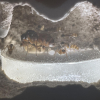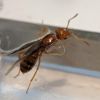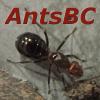1. Location (on a map) of collection:
2. Date of collection: June 24, 2019, approx 8pm
3. Habitat of collection: Was collected in school yard, in a grassy area, underneath debris from a fallen tree/rotting log, a few feet away from a paved surface. The wings were disturbed as demonstrated in the photos, which indicated to me this was not a disturbed nest. That said, other ants were in the general area, including C. pennsylvanicus .
4. Length (from head to gaster):6-7mm
5. Color, hue, pattern and texture: Honey brown, gaster appears to have stripes
6. Distinguishing characteristics: eyes appear tiny in my opinion. Gaster is small relative to body for a female (not 100% sure this is a female), unlike what is typically seen in many Camponotus sp
7. Distinguishing behavior: None
8. Nest description: Unknown
9. Nuptial flight time and date: Not witnessed
Having a bit of difficulty with ID. First thought was L. murphyi or similar parasitic Lasius sp. but having seen a number of those before, this did not clearly present itself to me as one, perhaps due to the wings obscuring my view of the distinctive body shape of same.
Thanks for any assistance with this one.




















